Zhong Cao
RADE: Learning Risk-Adjustable Driving Environment via Multi-Agent Conditional Diffusion
May 06, 2025Abstract:Generating safety-critical scenarios in high-fidelity simulations offers a promising and cost-effective approach for efficient testing of autonomous vehicles. Existing methods typically rely on manipulating a single vehicle's trajectory through sophisticated designed objectives to induce adversarial interactions, often at the cost of realism and scalability. In this work, we propose the Risk-Adjustable Driving Environment (RADE), a simulation framework that generates statistically realistic and risk-adjustable traffic scenes. Built upon a multi-agent diffusion architecture, RADE jointly models the behavior of all agents in the environment and conditions their trajectories on a surrogate risk measure. Unlike traditional adversarial methods, RADE learns risk-conditioned behaviors directly from data, preserving naturalistic multi-agent interactions with controllable risk levels. To ensure physical plausibility, we incorporate a tokenized dynamics check module that efficiently filters generated trajectories using a motion vocabulary. We validate RADE on the real-world rounD dataset, demonstrating that it preserves statistical realism across varying risk levels and naturally increases the likelihood of safety-critical events as the desired risk level grows up. Our results highlight RADE's potential as a scalable and realistic tool for AV safety evaluation.
LightEMMA: Lightweight End-to-End Multimodal Model for Autonomous Driving
May 01, 2025Abstract:Vision-Language Models (VLMs) have demonstrated significant potential for end-to-end autonomous driving. However, fully exploiting their capabilities for safe and reliable vehicle control remains an open research challenge. To systematically examine advances and limitations of VLMs in driving tasks, we introduce LightEMMA, a Lightweight End-to-End Multimodal Model for Autonomous driving. LightEMMA provides a unified, VLM-based autonomous driving framework without ad hoc customizations, enabling easy integration and evaluation of evolving state-of-the-art commercial and open-source models. We construct twelve autonomous driving agents using various VLMs and evaluate their performance on the nuScenes prediction task, comprehensively assessing metrics such as inference time, computational cost, and predictive accuracy. Illustrative examples highlight that, despite their strong scenario interpretation capabilities, VLMs' practical performance in autonomous driving tasks remains concerning, emphasizing the need for further improvements. The code is available at https://github.com/michigan-traffic-lab/LightEMMA.
Dynamically Local-Enhancement Planner for Large-Scale Autonomous Driving
Feb 28, 2025Abstract:Current autonomous vehicles operate primarily within limited regions, but there is increasing demand for broader applications. However, as models scale, their limited capacity becomes a significant challenge for adapting to novel scenarios. It is increasingly difficult to improve models for new situations using a single monolithic model. To address this issue, we introduce the concept of dynamically enhancing a basic driving planner with local driving data, without permanently modifying the planner itself. This approach, termed the Dynamically Local-Enhancement (DLE) Planner, aims to improve the scalability of autonomous driving systems without significantly expanding the planner's size. Our approach introduces a position-varying Markov Decision Process formulation coupled with a graph neural network that extracts region-specific driving features from local observation data. The learned features describe the local behavior of the surrounding objects, which is then leveraged to enhance a basic reinforcement learning-based policy. We evaluated our approach in multiple scenarios and compared it with a one-for-all driving model. The results show that our method outperforms the baseline policy in both safety (collision rate) and average reward, while maintaining a lighter scale. This approach has the potential to benefit large-scale autonomous vehicles without the need for largely expanding on-device driving models.
Uncertainty-Aware Prediction and Application in Planning for Autonomous Driving: Definitions, Methods, and Comparison
Mar 04, 2024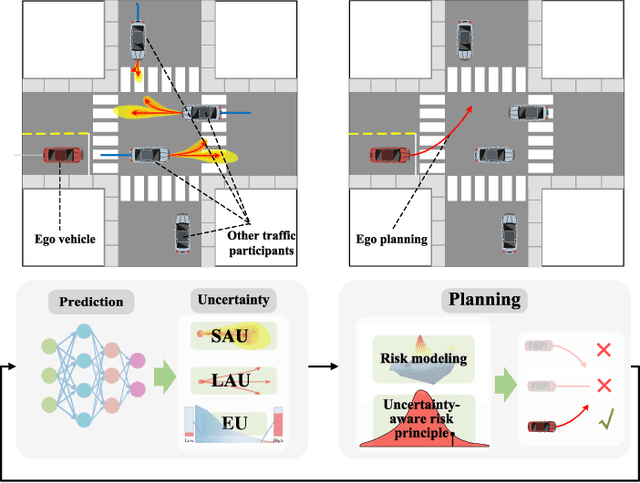

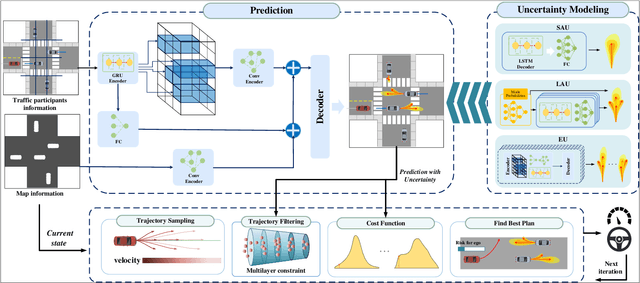

Abstract:Autonomous driving systems face the formidable challenge of navigating intricate and dynamic environments with uncertainty. This study presents a unified prediction and planning framework that concurrently models short-term aleatoric uncertainty (SAU), long-term aleatoric uncertainty (LAU), and epistemic uncertainty (EU) to predict and establish a robust foundation for planning in dynamic contexts. The framework uses Gaussian mixture models and deep ensemble methods, to concurrently capture and assess SAU, LAU, and EU, where traditional methods do not integrate these uncertainties simultaneously. Additionally, uncertainty-aware planning is introduced, considering various uncertainties. The study's contributions include comparisons of uncertainty estimations, risk modeling, and planning methods in comparison to existing approaches. The proposed methods were rigorously evaluated using the CommonRoad benchmark and settings with limited perception. These experiments illuminated the advantages and roles of different uncertainty factors in autonomous driving processes. In addition, comparative assessments of various uncertainty modeling strategies underscore the benefits of modeling multiple types of uncertainties, thus enhancing planning accuracy and reliability. The proposed framework facilitates the development of methods for UAP and surpasses existing uncertainty-aware risk models, particularly when considering diverse traffic scenarios. Project page: https://swb19.github.io/UAP/.
Scientific Preparation for CSST: Classification of Galaxy and Nebula/Star Cluster Based on Deep Learning
Dec 08, 2023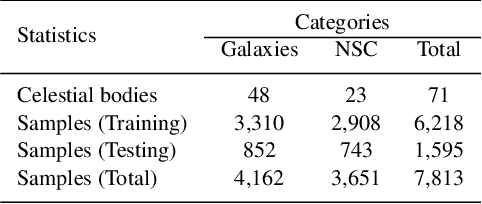


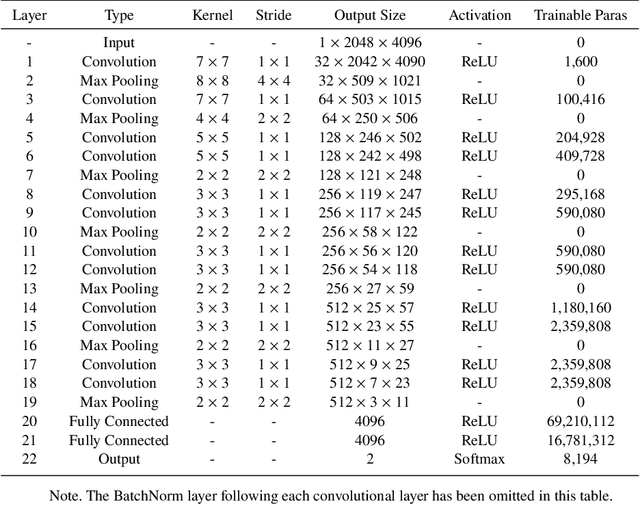
Abstract:The Chinese Space Station Telescope (abbreviated as CSST) is a future advanced space telescope. Real-time identification of galaxy and nebula/star cluster (abbreviated as NSC) images is of great value during CSST survey. While recent research on celestial object recognition has progressed, the rapid and efficient identification of high-resolution local celestial images remains challenging. In this study, we conducted galaxy and NSC image classification research using deep learning methods based on data from the Hubble Space Telescope. We built a Local Celestial Image Dataset and designed a deep learning model named HR-CelestialNet for classifying images of the galaxy and NSC. HR-CelestialNet achieved an accuracy of 89.09% on the testing set, outperforming models such as AlexNet, VGGNet and ResNet, while demonstrating faster recognition speeds. Furthermore, we investigated the factors influencing CSST image quality and evaluated the generalization ability of HR-CelestialNet on the blurry image dataset, demonstrating its robustness to low image quality. The proposed method can enable real-time identification of celestial images during CSST survey mission.
Dynamically Conservative Self-Driving Planner for Long-Tail Cases
May 12, 2023



Abstract:Self-driving vehicles (SDVs) are becoming reality but still suffer from "long-tail" challenges during natural driving: the SDVs will continually encounter rare, safety-critical cases that may not be included in the dataset they were trained. Some safety-assurance planners solve this problem by being conservative in all possible cases, which may significantly affect driving mobility. To this end, this work proposes a method to automatically adjust the conservative level according to each case's "long-tail" rate, named dynamically conservative planner (DCP). We first define the "long-tail" rate as an SDV's confidence to pass a driving case. The rate indicates the probability of safe-critical events and is estimated using the statistics bootstrapped method with historical data. Then, a reinforcement learning-based planner is designed to contain candidate policies with different conservative levels. The final policy is optimized based on the estimated "long-tail" rate. In this way, the DCP is designed to automatically adjust to be more conservative in low-confidence "long-tail" cases while keeping efficient otherwise. The DCP is evaluated in the CARLA simulator using driving cases with "long-tail" distributed training data. The results show that the DCP can accurately estimate the "long-tail" rate to identify potential risks. Based on the rate, the DCP automatically avoids potential collisions in "long-tail" cases using conservative decisions while not affecting the average velocity in other typical cases. Thus, the DCP is safer and more efficient than the baselines with fixed conservative levels, e.g., an always conservative planner. This work provides a technique to guarantee SDV's performance in unexpected driving cases without resorting to a global conservative setting, which contributes to solving the "long-tail" problem practically.
Identify, Estimate and Bound the Uncertainty of Reinforcement Learning for Autonomous Driving
May 12, 2023Abstract:Deep reinforcement learning (DRL) has emerged as a promising approach for developing more intelligent autonomous vehicles (AVs). A typical DRL application on AVs is to train a neural network-based driving policy. However, the black-box nature of neural networks can result in unpredictable decision failures, making such AVs unreliable. To this end, this work proposes a method to identify and protect unreliable decisions of a DRL driving policy. The basic idea is to estimate and constrain the policy's performance uncertainty, which quantifies potential performance drop due to insufficient training data or network fitting errors. By constraining the uncertainty, the DRL model's performance is always greater than that of a baseline policy. The uncertainty caused by insufficient data is estimated by the bootstrapped method. Then, the uncertainty caused by the network fitting error is estimated using an ensemble network. Finally, a baseline policy is added as the performance lower bound to avoid potential decision failures. The overall framework is called uncertainty-bound reinforcement learning (UBRL). The proposed UBRL is evaluated on DRL policies with different amounts of training data, taking an unprotected left-turn driving case as an example. The result shows that the UBRL method can identify potentially unreliable decisions of DRL policy. The UBRL guarantees to outperform baseline policy even when the DRL policy is not well-trained and has high uncertainty. Meanwhile, the performance of UBRL improves with more training data. Such a method is valuable for the DRL application on real-road driving and provides a metric to evaluate a DRL policy.
Privacy of Autonomous Vehicles: Risks, Protection Methods, and Future Directions
Sep 08, 2022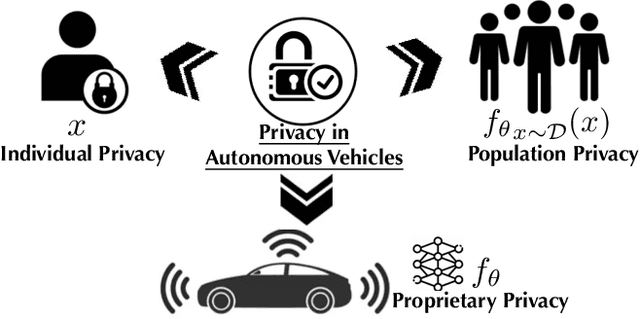
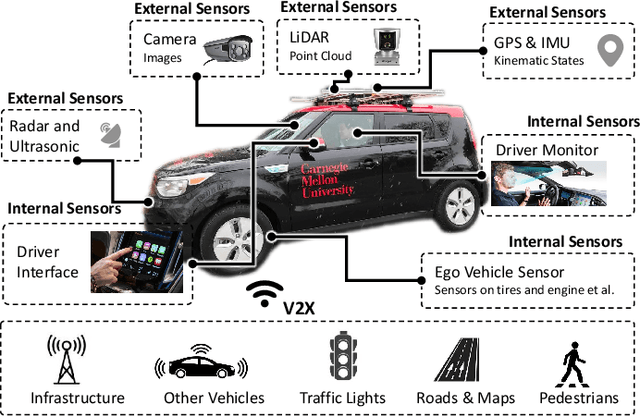
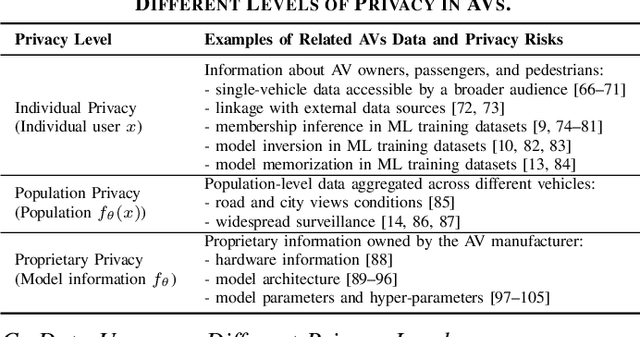
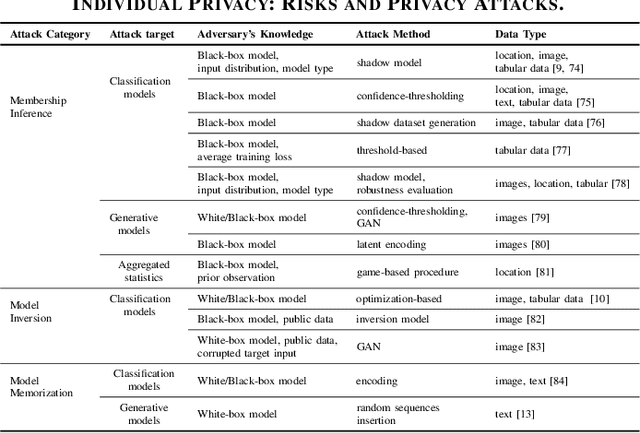
Abstract:Recent advances in machine learning have enabled its wide application in different domains, and one of the most exciting applications is autonomous vehicles (AVs), which have encouraged the development of a number of ML algorithms from perception to prediction to planning. However, training AVs usually requires a large amount of training data collected from different driving environments (e.g., cities) as well as different types of personal information (e.g., working hours and routes). Such collected large data, treated as the new oil for ML in the data-centric AI era, usually contains a large amount of privacy-sensitive information which is hard to remove or even audit. Although existing privacy protection approaches have achieved certain theoretical and empirical success, there is still a gap when applying them to real-world applications such as autonomous vehicles. For instance, when training AVs, not only can individually identifiable information reveal privacy-sensitive information, but also population-level information such as road construction within a city, and proprietary-level commercial secrets of AVs. Thus, it is critical to revisit the frontier of privacy risks and corresponding protection approaches in AVs to bridge this gap. Following this goal, in this work, we provide a new taxonomy for privacy risks and protection methods in AVs, and we categorize privacy in AVs into three levels: individual, population, and proprietary. We explicitly list out recent challenges to protect each of these levels of privacy, summarize existing solutions to these challenges, discuss the lessons and conclusions, and provide potential future directions and opportunities for both researchers and practitioners. We believe this work will help to shape the privacy research in AV and guide the privacy protection technology design.
Long-Tail Prediction Uncertainty Aware Trajectory Planning for Self-driving Vehicles
Jul 02, 2022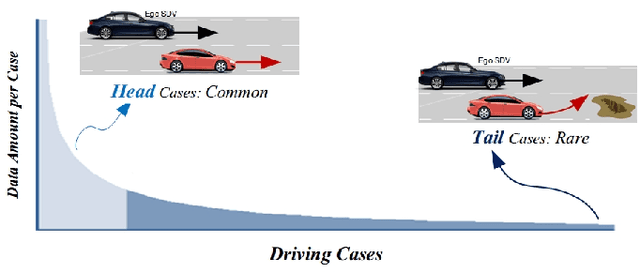
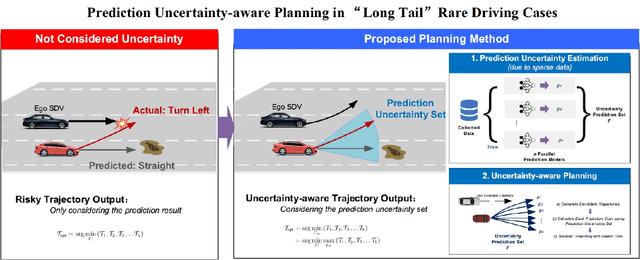
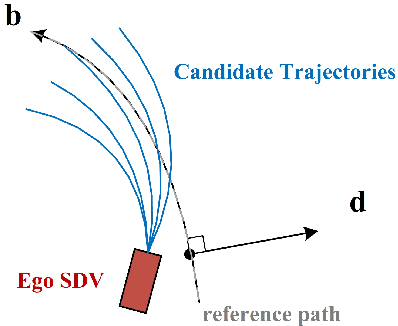
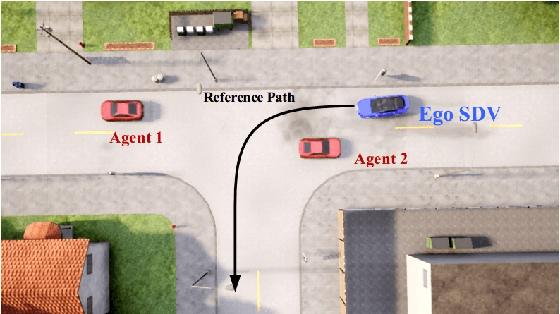
Abstract:A typical trajectory planner of autonomous driving usually relies on predicting the future behavior of surrounding obstacles. In recent years, prediction models based on deep learning have been widely used due to their impressive performance. However, recent studies have shown that deep learning models trained on a dataset following a long-tailed driving scenario distribution will suffer from large prediction errors in the "tails," which might lead to failures of the planner. To this end, this work defines a notion of prediction model uncertainty to quantify high errors due to sparse data. Moreover, this work proposes a trajectory planner to consider such prediction uncertainty for safer performance. Firstly, the prediction model's uncertainty due to insufficient training data is estimated by an ensemble network structure. Then a trajectory planner is designed to consider the worst-case arising from prediction uncertainty. The results show that the proposed method can improve the safety of trajectory planning under the prediction uncertainty caused by insufficient data. At the same time, with sufficient data, the framework will not lead to overly conservative results. This technology helps to improve the safety and reliability of autonomous vehicles under the long-tail data distribution of the real world.
Road Traffic Law Adaptive Decision-making for Self-Driving Vehicles
Apr 26, 2022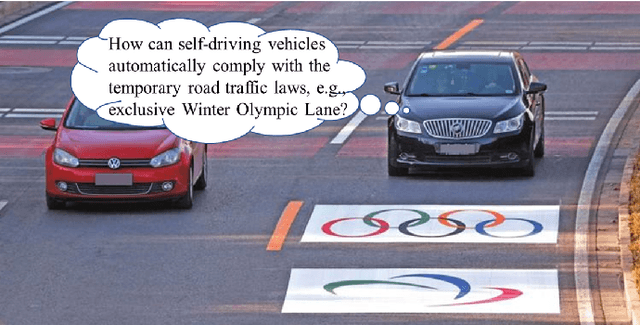
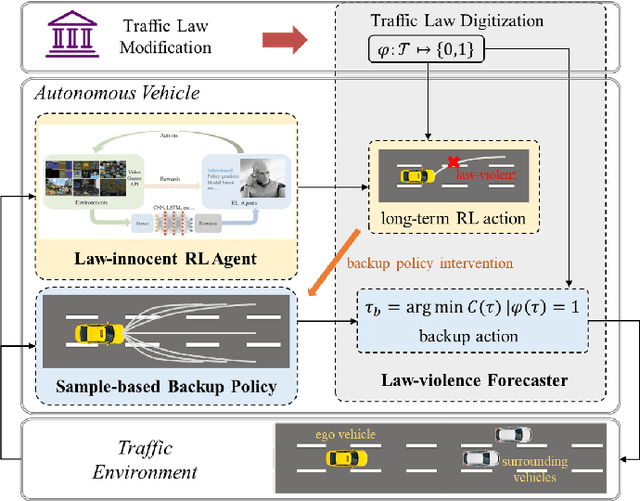
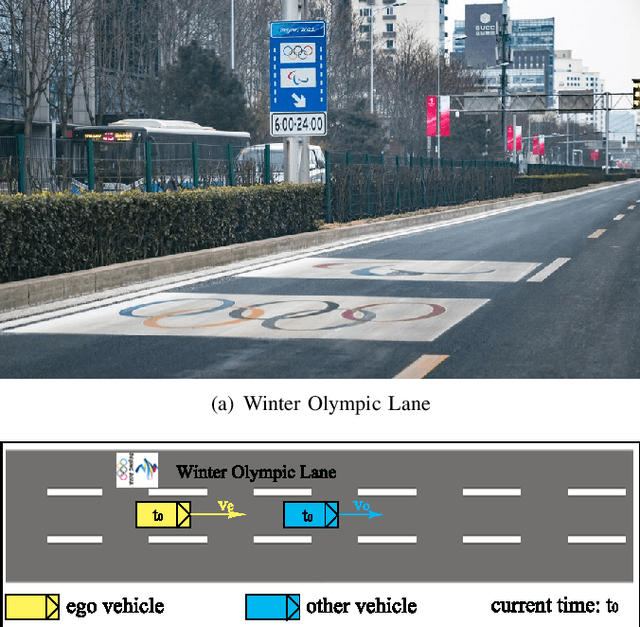

Abstract:Self-driving vehicles have their own intelligence to drive on open roads. However, vehicle managers, e.g., government or industrial companies, still need a way to tell these self-driving vehicles what behaviors are encouraged or forbidden. Unlike human drivers, current self-driving vehicles cannot understand the traffic laws, thus rely on the programmers manually writing the corresponding principles into the driving systems. It would be less efficient and hard to adapt some temporary traffic laws, especially when the vehicles use data-driven decision-making algorithms. Besides, current self-driving vehicle systems rarely take traffic law modification into consideration. This work aims to design a road traffic law adaptive decision-making method. The decision-making algorithm is designed based on reinforcement learning, in which the traffic rules are usually implicitly coded in deep neural networks. The main idea is to supply the adaptability to traffic laws of self-driving vehicles by a law-adaptive backup policy. In this work, the natural language-based traffic laws are first translated into a logical expression by the Linear Temporal Logic method. Then, the system will try to monitor in advance whether the self-driving vehicle may break the traffic laws by designing a long-term RL action space. Finally, a sample-based planning method will re-plan the trajectory when the vehicle may break the traffic rules. The method is validated in a Beijing Winter Olympic Lane scenario and an overtaking case, built in CARLA simulator. The results show that by adopting this method, the self-driving vehicles can comply with new issued or updated traffic laws effectively. This method helps self-driving vehicles governed by digital traffic laws, which is necessary for the wide adoption of autonomous driving.
 Add to Chrome
Add to Chrome Add to Firefox
Add to Firefox Add to Edge
Add to Edge